The title may sound like clickbait, but read below and you’ll find that it’s frighteningly not so.
But first, today’s video mashup includes Josep Borrell, once again intimating that the Ukraine war would end in mere days were the West to stop funding Zelensky’s regime. This very frank admission should give everyone an idea of how fragile Ukraine’s position is, and how desperately they hang on by a thread.
The second series of videos demonstrates Russia’s massive strike, called by some the largest of the entire war thus far, on Ukraine’s Khmelnitsky ammot depot. This is merely to illustrate the next point I wish to make, which is that there is a lot of ‘recency bias’ that goes into yesterday’s attacks on the Russian air fleet. Suddenly there is doom and gloom, and the typical, expected ‘concern troll’ swarm, etc. But many people quickly forget how vast the damage is which Russia is inflicting on Ukraine on a daily basis. The cost estimate of the above Khmelnitsky strike alone was said to be over $500 million, according to DPR’s Basurin and other sources.
Rybar:
They have shaken the earth's firmament.
Yesterday's massive strike on the Khmelnytskyi warehouses is shaking the ground.
Our sources say that the 649th aviation depot of missile weapons and ammunition in the village of Hrushevitsya stored a significant number of anti-aircraft missiles for Western-made SAMs - including those for Patriot SAMs.
According to the earthquake monitoring system of the Euro-Mediterranean Seismological Centre, tremors of 3.4 magnitude were felt northwest of Khmelnytskyy at 04.52 Moscow time.
This fact indicates that the impact on the depots was very effective - the secondary detonation of the weapons caused seismological activity in the earth's crust.
Yes, not all the stockpiles were in Grushevitsa. The Ukrainian command has been storing weapons in various depots across the country since last spring. But with periodic Russian UAV and missile raids, the loss of even a batch of anti-aircraft missiles would affect Ukraine's air defence capabilities.
Ayden here, summarizes the view:
A Ukrainian military post complaining about how many ‘eggs’ were placed in one basket in Khmelnitsky:
In Khmelnitsky, a fire was extinguished yesterday after a strike on military warehouses. It is claimed that in addition to ammunition, 83 million euros worth of satellite communication systems, military tablets, and data encryption systems were destroyed. According to available information, a total of €200-220 million was blown up. Cargo from Denmark, Germany, Italy, Japan.
In fact, an interesting RUMINT report has come out regarding this strike:
Further Khmelnitsky Depleted Uranium Update.
Excellent research by Gleb Georgievich Gerasimov.
A clear spike in gamma radiation was detected in Khmelnitsky on or about May 12th, with emission continuing to rise the following day and remaining at the elevated level thereafter.
Considering how little gamma radiation comes from depleted uranium, this clear spike in gamma radiation in Khmelnitsky indicates that there was very large stockpile of the DU munitions that was destroyed, raising the uranium dust into the air.
By comparison, the towns of Ternopol, Khmilnik, and Novaya Ushitsa (images 3, 4, and 5) remained at their apparent regular, base levels. This indicates that the Khmelnitsky anomaly is indeed a spike and corroborates the claim that the stockpile in Khmelnitsky contained DU munitions. The map viewed is attached as the sixth image.
This British gift will keep on giving.
🇷🇺🇺🇦.It is worth noting that panic reports are spreading in Ukrainian social networks that during the detonation of an ammunition depot in Khmelnytsky, a large batch of British tank ammunition with depleted uranium, which was recently brought to Ukraine along with Storm Shadow missiles, was also destroyed. As a result of a huge explosion, particles of depleted uranium could be dispersed on the territory of the Khmelnytsky region, which, taking into account the experience of Yugoslavia and Iraq, could lead to an outbreak of cancer in the medium term.
There are already reports that the radiation background has allegedly increased in Khmelnitsky. Let's wait for actual confirmation.
The mentioned Ternopil was also dealt a devastating blow last night, as well as other areas:
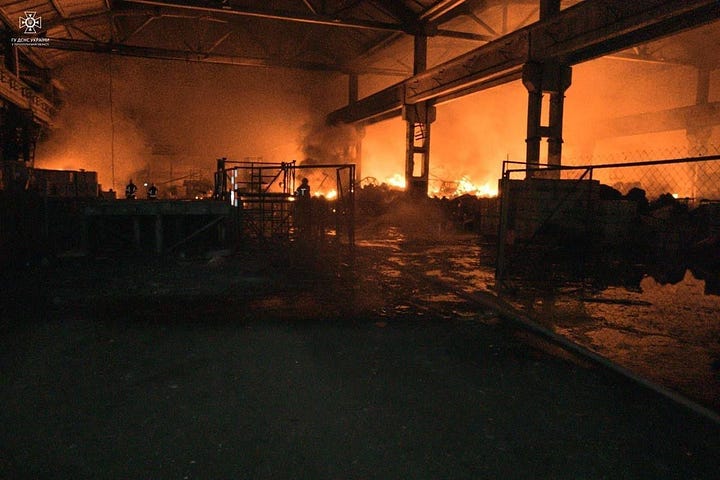
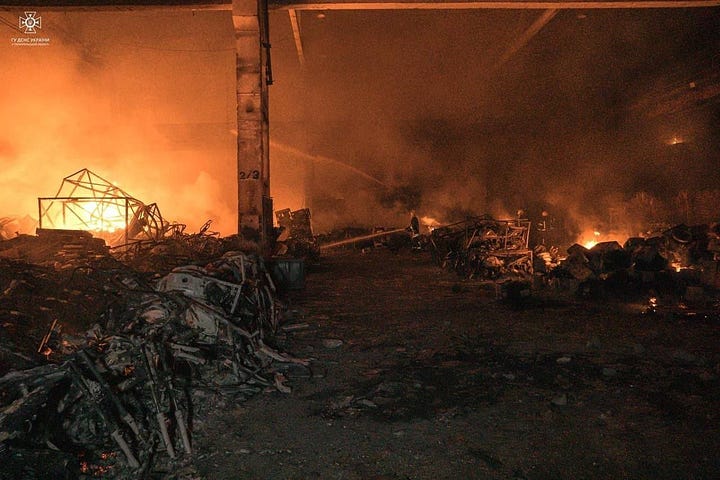
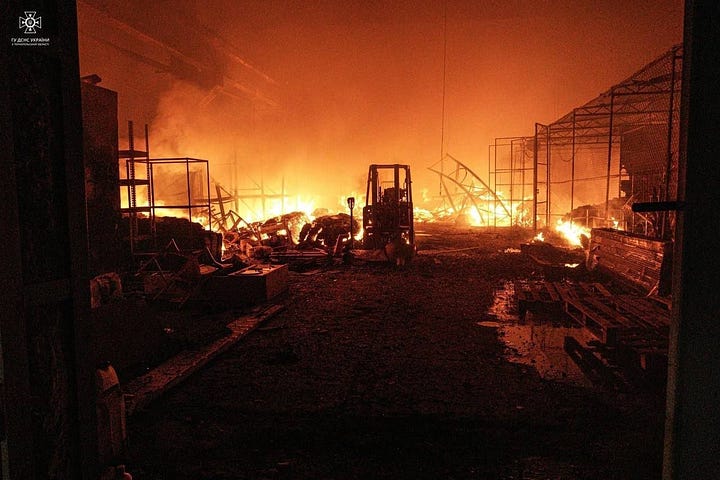
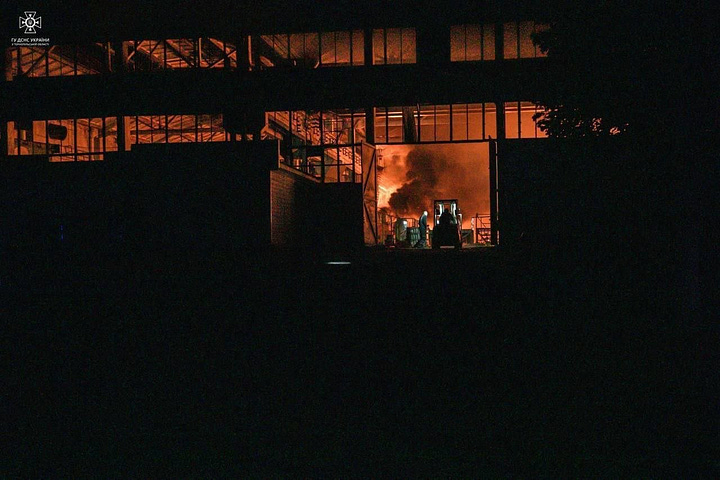
Russia inflicts such destruction that is several times more serious than even the loss of four aircraft, and it does this on a daily basis to Ukraine. Yet recency bias ensures that people glom onto the aircraft downings and forget all else, as if Russia has suddenly magically stopped winning because of one fluke occurrence.
The truth of the matter is, Russia has actually not sustained a single serious aircraft loss in quite some time now. There was a time last summer, give or take, where it was a regular weekly occurrence for them to lose at least one Su-34 or something similar. But in the past few months they’ve lost almost nothing; it has been a tremendous run, likely owed to the depletion of UA air defense. So this four losses simply catches the number up a bit. But it still pales in comparison to the massive losses being inflicted on Ukraine on a daily basis. After all, if that wasn’t the case then people like Josep Borrell wouldn’t be saying that Ukraine would collapse in literal days if Western support stopped.
Even in Bakhmut, they are still being dealt grievous blows. One source about Bakhmut counter-offensive battles:
The AFU sacrificed nearby to 2,500 personnel and dozens of military vehicles (incl. 1 Leopard destroyed by AT Mine) for their counteroffensive nearby to the Berkhoviskoye Reseirvoir and within the Soledar Tactical Region. The AFU General Staff did not anticipate this many losses; and may struggle with organising future assaults until this number is replenished with fresh meat.
Some may balk at the above; perhaps 2,500 sounds a tad high. But then ask yourself, why has this supremely successful counter-offensive stopped? If they were bulldozing over the poor Russian mobilized, who fled in horror at their approach, why haven’t they gloriously continued on? It appears to have flamed out or hit a wall of some kind. Typically, sustaining disproportionate losses is the only type of wall one could hit that would put an abrupt end to such a brief offensive. It couldn’t have been fuel or ammo, as it would be hard to expend that much in a mere couple days of fighting.
With that said, other sources claim only 1,000 men total were used in the offensive, but this is hard to believe given simply the sheer amount of areas, both north and south, which they attacked. If 1k were used over such an area, that would mean some areas would only have been a mere company or less doing the assault.
On that topic, a few updates. Prigozhin continues to claim major friction with Russian MOD:
Though, for the first time he praised a few Russian units:
“Tonight, the enemy did not take any action to advance further. On the Berkhovsky reservoir, we were forced, as I have already said, to place part of our units in order to hold back the further advance of the enemy. Those fighters [of the RF Armed Forces] who did not run away from the lost positions joined us. Some of them quite successfully occupy their positions and, built into the overall system, deflect the enemy's offensive. As for the constant information that the Airborne Forces are helping us, I don’t know, I haven’t seen them. The Airborne Forces, in theory, were supposed to recapture those positions that were lost by other units. But, as far as I know, these positions are still under the enemy control. Therefore, I do not know where the Airborne Forces are and who they help. PMC "Wagner" continues to move inside Bakhmut. As soon as we slam Bakhmut, then the task of the Airborne Forces or other units is to keep it [Bakhmut]” - Prigozhin said in a statement
A brief note on the above. Yesterday in the comments someone had a good question about, why is it all these purportedly ‘fleeing’ units always appear to be LPR/volunteers/etc. as per my reporting, and there is never any news about actual Russian units. Where are the actual Russian units?
To clear that up a bit:
Firstly, I wasn’t saying with 100% certainty none of the units related to all the recent Bakhmut counter-offensive drama were Russian, but simply that all the unit names I had personally seen and researched, I couldn’t find a 100% definitive Russian unit amongst them. One that was the focus of much discussion, the 72nd, is claimed to be Russian, and I’m not necessarily doubting that it is, but I cannot find any info on it from official Russian OOBs. Maybe it’s a new unit. The ones I did find or already know about (such as the 2nd and 3rd Corps) are known LPR/volunteer brigades.
There was one I was uncertain about, the 374th, however a new video released today appeared to show a Russian unit identified as the 374th claiming to want to join Wagner. It’s not fully confirmed but we can assume this is a Russian mobilized unit. Also, I’ve come across a new unit that appeared to have taken part in the Bakhmut drama, the 200th separate motor rifle from Murmansk, though I’m not 100% certain—but they appear to possibly be one of the units Prigozhin is referring to in the statement above, based on this report from today:
4th, 200th motorized rifle brigades and the 6th motorized Rifle Division seem to have redeemed themselves during the night and stopped the bleeding on Wagner flanks for now, although it appears to have cost them a few commanders. Monitoring situation.
From Russian MOD:
Ministry of Defense of the Russian Federation on the attacks of the Armed Forces of Ukraine east of Bogdanovka (direction of the Berkhovsky reservoir).
Motorized infantry units of the 3rd battalion of the 200th Motorized Rifle Brigade repelled six attacks east of Bogdanovka in the Donetsk People's Republic. The attacks involved assault groups of the Armed Forces of Ukraine numbering more than 100 people, seven tanks, 14 infantry fighting vehicles, as well as other military and special equipment; seven tanks, 11 infantry fighting vehicles and more than 50 Ukrainian servicemen were destroyed;
In the area of responsibility of the 6th Division, an attack by enemy assault groups supported by three tanks was repelled and four infantry fighting vehicles; enemy losses amounted to more than 30 Ukrainian servicemen, two tanks and three infantry fighting vehicles. (Ministry of Defense of the Russian Federation)
The ‘cost commanders’ refers to commanders Bravko and Makarov allegedly killed from the 4th motorized rifle brigade, which is an LPR brigade.
As to where the true concentrations of Russian troops are: of course, the Kremennaya-Svatovo line has one of the highest concentrations. Not only VDV airborne but 1st guards tank army (4th guards tank division, etc.) as well as many other motor rifle brigade units.
The Kherson and Zaporozhye region is also saturated with actual Russian units. For instance, I personally know of the 219th motorized rifle regiment of the 42nd guards motorized rifle division of the 58th army in the Pologi region, which is kind of at the center between west Zaporozhye and Ugledar. 22nd separate guards special forces are also there.
In Marinka, we have the 20th guards motor rifle of the Russian army. The 132nd separate guards motorized are in Avdeevka. Of course, it’s well known that many Russian naval / marine groups are around the Ugledar area, such as the 155th Black Sea Fleet marines as well as the 40th naval infantry from Russia’s far east.
But Russia is said to also be heavily supporting the Bakhmut operations with artillery forces, but of course you’ll never hear about that since they’re firing from the rear and not on the front contact line, so there will never be a ‘retreat’ from them.
Either way, I think there are much more Russian units in and around Bakhmut than we know of, including those mysterious VDV that Prigozhin claims to not be able to find, but for similar reasons you don’t hear about them because the more elite units like VDV aren’t the ones retreating, so they’re not generating headlines, but rather quietly holding their positions.
With that cleared up, let’s back up to the shot down aircraft situation once more.
I’ve previously posted this video of the CEO of Rostec stating how all of last year, Russia produced about ~150 total helicopters, and this year alone, Russia is already at the ~300+ mark just in the first five months. Russian aviation across the board has gone up in production, and if there’s one thing Russia knows, it’s aviation production:
Aerospace was a well-developed industry in the Soviet Union. In late 1980s, the Soviet Union accounted for 25% of the worldwide civilian and 40% of the worldwide military aircraft production.
Of course, Russian fighter jet/bomber production is far slower than that of helicopters. In previous years, they’ve only produced a handful of the top, most sophisticated 4th generation jet aircraft per year:
But my point is that, production should still increase commensurately in ratio, at least. Take for instance the Su-34, which was shot down yesterday. As can be seen, during peak years they could produce 18 of them. The production only slowed because they saw no further need to produce much more, as the contract signed long ago for a set number was being wound down.
The last two Su-34s of the 2012 contract were delivered to the 968th Fighter Aviation Regiment at the Lipetsk Air Base in December 2020. This brought the total number of operational aircraft delivered to the Russian Air Force to 131 (not counting crashes and aircraft written off). Apart from this, also seven pre-production units were built under previous contracts.
As can be seen from the above report, they only produced low numbers to finish off the contract. But with new contracts for the SMO, they can easily surpass even the 18 per year they had done at their peak.
Most current ramp ups through all Russian industries are at least 3X in production gains simply because most industries are adding triple shifts (for instance, 3 x 8 hour shifts per day rather than 1). So, we can roughly assume that Su-34s can be produced at a rate of maybe 18 x 3 at the minimum, and perhaps even more, depending on the scale of the ramp ups that have occurred since the start of the SMO.
Taking Oryx’s list as a baseline example—even if it’s exaggerated—he has 20 Russian Su-34s lost, and 3 Russian Su-35s total in the SMO so far. As can be seen here, Russia can make up the losses of those 20 x Su-34s in just a single year of normal production, not even counting ramp ups. That means it can be safe to assume that Russia has already not only long made up for the Su-34 losses of the SMO, but is likely exceeding them with new production. Even if Russia only ramped up its previous production ‘slightly’ from 18 per year to 20-30, it would have already more than made up for any losses.
And for Su-35s it’s even more drastic, as Russia has hardly lost any of those. Recall, Russia is reportedly selling upwards of 60 Su-35s to Iran, deliveries to start next week as per this breaking headline from today:
Do you think Russia is having jet availability issues if they’re literally offloading upwards of 60 of these Su-35s onto Iran? Clearly, Russia is not worried.
The point is, a few shot down aircraft is really nothing for an economic power house like Russia. In fact, some have rightly pointed out that the shot down Mi-8MTPR1 is more tragic as Russia reportedly only had 10-20 of them total, as they are valuable electronic aircraft. But, I’m sure Russia is ramping that up as well. And it’s in no short supply of Mi-8s to upgrade to the MTPR standard—Russia has around ~800 total Mi-8/17s.
Of course, the largest tragedy of all was the loss of the pilots themselves, not these easily replaceable craft.
On that note, a few updates on that incident, including some new theories.
From Rybar:
We sustained the necessary pause after the destruction of our aviation group yesterday in the Bryansk region.
Unfortunately, no official version or at least some kind of statement from the law enforcement agencies was made. The only thing that exists is a duck about the ignition of the engine of one Mi-8 from a TASS source.
Our working version yesterday was an ambush by a fighter squadron based in Mirgorod, Poltava region. The Polish MiGs in service with the Armed Forces of Ukraine are capable of firing AIM-120 deep into Russian territories.
However, after consulting with War-Turned @voenacher and our undercover sources on the ground, we have changed our minds.
With a probability of 95%, the ambush was carried out with NASAMS air defense systems, whose crew knew the exact corridor along which the Russian aviation group was supposed to fly. Local residents saw six simultaneous launches in the north of the Chernihiv region.
The Air Defense Forces of Ukraine have issued instructions to hunt our pilots along the state border. For this, air defense systems delivered from abroad will be used, thereby testing them in the Ukrainian theater of operations.
In Ukraine, they decided to declare that this is the work of Russian air defense and a crossbow, thereby "whitewashing" Western partners.
We can and do argue that this is not the case.
Firstly, let me say that NASAMs on paper has far too short a range, around 40-50km, to have hit the areas 80-100km away where some of the aircraft crashed. However, some have stated that the latest variant of NASAMs can fire the Aim-120 Amraam with 120km range. The latest variant of NASAMs-3 can fire the Amraam-ER extended range version.
According to another version, a bomber group of Su-34s and two Mi-8MTPR-1 electronic cover helicopters with Rychag-AV complexes could have been attacked by Ukrainian Air Force planes armed with American AIM-120 missiles at the exit from the bomb drop zone.
In the AIM-120A/B/C versions, the target range is up to 50 kilometers. The AIM-120C-5/6/7 version allows you to hit targets at twice the range-105 kilometers. The AIM-120D version is considered the longest-range version — the range of this missile is approximately 150-160 kilometers.As you know, missiles of this type are equipped with active radar homing heads, which immediately after launch can operate in the interference guidance mode (HOJ) emitted by electronic warfare systems of combat aircraft and helicopters. These complexes could be included in the Rychag-AV and Khibiny stations installed on the Su-34 and Mi-8. Moreover, these homing heads have high noise immunity, which makes it possible to separate the reflected signal from interference when approaching targets. (Military chronicle of TG)
Someone in the comments did mention the SLAMRAAM possibility, a very transportable Humvee armed with Amraams:
If I’m understanding the system correctly, it can operate with Link-16 data transfer which means the highly mobile and concealable Humvee can get radar target coordinates from a radar positioned much farther away, then launch these deadly missiles at the target. This does appear a plausible culprit.
Plus, the report of civilians on the ground supposedly seeing six simultaneous launches from north Chernigov is interesting. This at least seems to confirm that it wasn’t Manpads or an air-to-air kill (i.e. the “Mig theory”).
Also, some have pointed out that in the one video of the hit, the missile’s dimensions can be roughly inferred:
Hmmm. A R-27 is 4 meters long, AIM-120 3.65 meters long, neither fits very well. And the helicopters were reportedly providing EW, which would interfere with long-range radar-guided anything.
Both S-300 and BUK missiles are upwards of 7 meters long. That means, if the helicopter’s rotor blades are 10m in the above photo, the missile should appear nearly as long as the blades. Yet the small blip seems 1/3 the size, which would to me actually point to an Aim-120 from the NASAMs/SLAMRAAM platform. It certainly is too large for Manpad, which would be nearly invisible on camera as they are very small.
So, for now, absent any new information, I would have to concur that this is most likely a ground-fired Amraam as the missile in the photo is no where near big enough for a BUK/S-300.
Another take:
Operational aspect (of the losses of Russian aircraft yesterday)
It is now clear that this was an ambush by the Armed Forces of Ukraine on a group that worked with glide bombs.
The group included:
— SU-34 fighter-bomber, in fact, which carried bombs;
— 2 MI-8 helicopters in a special electronic warfare configuration
— fighter-interceptor SU-35, covered.
The Russian Aerospace Forces have been striking with UPMK bombs in northern Ukraine for a long time. The Russian Defence Ministry is very fond of “not complicating” what works, so we agree with the opinion that the actions of such strike groups are most likely of the same type and predictable.
The General Staff of the Armed Forces of Ukraine with the NATO headquarters quickly assessed the possibilities and prepared an "ambush".
Local channels immediately wrote nonsense about the Stingers, which the Strelkovs and co. carried on. We are not air defence specialists, but the video with the downing of the first MI-8 clearly shows that:
— the rocket enters the cockpit from the nose;
— the rocket is big.
Accordingly, this is not a MANPADS, in which the missiles are small and enter the target from behind (usually).
Either these are NATO air-to-air missiles, or the Armed Forces of Ukraine secretly rolled up to the very border of the air defence system.
Also against the version with MANPADS is the fact that the pilots died. Usually a small MANPADS missile hits the engine, and the armoured capsule easily withstands this.
It is interesting that the protection systems did not work for the helicopters: they did not manoeuvre and did not discard the heat traps. This is weird. Possibly due to some tricky targeting option.
Strategic level:
Probably the action was conceived for Ze's visit to Rome. Zelensky's last visit to Helsinki was accompanied by a blow to the Kremlin. Coincidence?
Ukrainian "new Arestoviches" write about the unprecedented slap in the face of the Russian Federation, the need for a nuclear response and the imminent end of the war in view of a strong blow to the image. It is clear that, on the instructions of Yermak, they inspire false optimism by painting an illusory picture.
Yes, this is a very successful operation of the Armed Forces of Ukraine. Russia lost 9 pilots and equipment worth about $100 million. Yes, it hurts them, but it's not fatal.
This cannot be compared with the loss of the flagship of the Black Sea Fleet or with the flight from Kharkov.
Therefore, it is not necessary to inspire people with false hopes for selfish purposes, this will not affect the strategic alignment.
Rather, it is an image strengthening of Ze's negotiating positions by finding weaknesses in the tactics of the Russian Federation.
The above summarizes my own views. It’s a slap in the face, but no where near the slaps that Russia is producing daily for the AFU.
For now, Russia continues shooting down Western missiles, including this American AGM-88 HARM shot down near Kremennaya which gave an interesting glimpse into the type of ‘fresh stock’ that UA is supplied with. Check the expiration date:
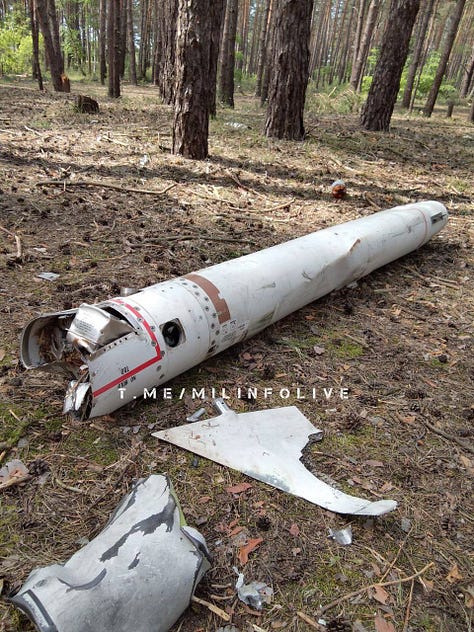


As a last update for today, despite Prigozhin’s ceaseless whinging, Wagner has again advanced in Bakhmut’s final districts:
🔥PMC "Wagner" advanced 130 meters and took 28 high-rise buildings turned into fortresses in the fortified area "Gnezdo" in Bakhmut, the Armed Forces of Ukraine have 20 high-rise buildings left
E. Prigogine:
- "Today, units of PMC" Wagner "moved up to 130 m in the so-called" Nest "and around it.
- PMC assault groups occupied 91,000 meters.
- Under the control of the Ukrainian forces remains - 1.69 square kilometers of Bakhmut.
- During the day, 9 high-rise buildings were liberated, under the control of the orchestra fighters - 28 high-rise buildings, under the control of the Armed Forces of Ukraine - 20.
“Assault groups continue to carry out tasks for the final capture of Bakhmut, and also work on the flanks, where they had to stay to suppress attempts to break through.”
We’ll watch and see how the situation develops after this. Until next time!
If you enjoyed the read, I would greatly appreciate if you subscribed to a monthly/yearly pledge to support my work, so that I may continue providing you with detailed, incisive reports like this one.
Alternatively, you can tip here: Tip Jar



















Share this post